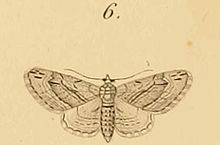Eupithecia phoeniceata, the cypress pug, is a moth of the family Geometridae. The species was first described by Jules Pierre Rambur in 1834 and it can be found in Europe.
| Eupithecia phoeniceata | |
|---|---|

| |

| |
| Rambur's original illustration | |
| Scientific classification | |
| Domain: | Eukaryota |
| Kingdom: | Animalia |
| Phylum: | Arthropoda |
| Class: | Insecta |
| Order: | Lepidoptera |
| Family: | Geometridae |
| Genus: | Eupithecia |
| Species: | E. phoeniceata
|
| Binomial name | |
| Eupithecia phoeniceata | |
| Synonyms | |
| |
The wingspan is 18–22 mm. The ground colour of the forewings is grey or pale greyish ochreous conspicuously patterned with a characteristic extremely oblique pale median fascia, which makes the wing appear narrower than it really is. There are blackish-marked veins near the termen. Forewings with a small dark discal spot. The forewings are distinctly elongate. The hindwings have variable markings but usually resemble the forewings. The thorax is grey, with an anterior black collar.[2][3]
The moths flies from August to September depending on the location.
The larvae feed on Cupressus macrocarpa and other cultivars.
References
edit- ^ Yu, Dicky Sick Ki. "Eupithecia phoeniceata (Rambur 1834)". Home of Ichneumonoidea. Taxapad. Archived from the original on 24 March 2016.
- ^ Eupithecia phoeniceata full description Watson, L., and Dallwitz, M.J. 2003 onwards. British Insects: The Genera of Lepidoptera-Geometridae. Version: 29 December 2011
- ^ Prout, L. B. (1912–16). Geometridae. In A. Seitz (ed.) The Macrolepidoptera of the World. The Palaearctic Geometridae, 4. 479 pp. Alfred Kernen, Stuttgart.pdf * This article incorporates text from this source, which is in the public domain.
External links
edit